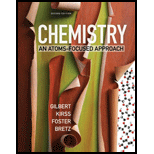
To find:
a) The fuel values of gaseous benzene and ethylene gas based on the thermochemical data in Appendix 4.
b) Does one mole of benzene have higher or lower fuel value than three moles of ethylene.
Answer to Problem 19.69QA
Solution:
a) Fuel value of benzene is
b) One mole of benzenehas alower fuel value than three mole ethylene.
Explanation of Solution
1) Concept:
To calculate the fuel value of the compound, we need to use heat of combustion of fuel and molar mass. First we will write the combustion reaction of gaseous benzene and ethylene gas. Then we will calculate the
Fuel value is the quantity of energy released during the complete combustion of 1 g of a substance.
2) Formula:
i)
ii)
3) Given:
i) ![]()
ii) ![]()
iii) ![]()
iv)
v) ![]()
vi) ![]()
vii) ![]()
4) Calculations:
Write the balanced combustion reaction of benzene.
Calculate the
If we divide the absolute value of
The fuel value of benzeneis
Write the balanced combustion reaction of ethylene.
Calculate the
If we divide the absolute value of
The fuel value of ethyleneis
The fuel value of one mole of benzene is lower than 3 mole of ethylene.
Conclusion:
The fuel value is calculated from the thermodynamic data, combustion reaction, and molar mass.
Want to see more full solutions like this?
Chapter 19 Solutions
CHEM:ATOM FOC 2E CL (TEXT)
 ChemistryChemistryISBN:9781305957404Author:Steven S. Zumdahl, Susan A. Zumdahl, Donald J. DeCostePublisher:Cengage Learning
ChemistryChemistryISBN:9781305957404Author:Steven S. Zumdahl, Susan A. Zumdahl, Donald J. DeCostePublisher:Cengage Learning ChemistryChemistryISBN:9781259911156Author:Raymond Chang Dr., Jason Overby ProfessorPublisher:McGraw-Hill Education
ChemistryChemistryISBN:9781259911156Author:Raymond Chang Dr., Jason Overby ProfessorPublisher:McGraw-Hill Education Principles of Instrumental AnalysisChemistryISBN:9781305577213Author:Douglas A. Skoog, F. James Holler, Stanley R. CrouchPublisher:Cengage Learning
Principles of Instrumental AnalysisChemistryISBN:9781305577213Author:Douglas A. Skoog, F. James Holler, Stanley R. CrouchPublisher:Cengage Learning Organic ChemistryChemistryISBN:9780078021558Author:Janice Gorzynski Smith Dr.Publisher:McGraw-Hill Education
Organic ChemistryChemistryISBN:9780078021558Author:Janice Gorzynski Smith Dr.Publisher:McGraw-Hill Education Chemistry: Principles and ReactionsChemistryISBN:9781305079373Author:William L. Masterton, Cecile N. HurleyPublisher:Cengage Learning
Chemistry: Principles and ReactionsChemistryISBN:9781305079373Author:William L. Masterton, Cecile N. HurleyPublisher:Cengage Learning Elementary Principles of Chemical Processes, Bind...ChemistryISBN:9781118431221Author:Richard M. Felder, Ronald W. Rousseau, Lisa G. BullardPublisher:WILEY
Elementary Principles of Chemical Processes, Bind...ChemistryISBN:9781118431221Author:Richard M. Felder, Ronald W. Rousseau, Lisa G. BullardPublisher:WILEY





